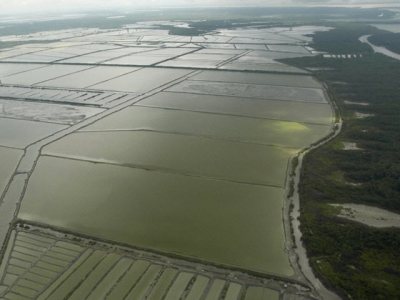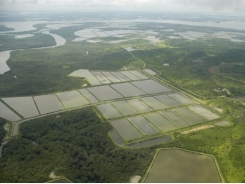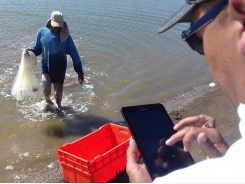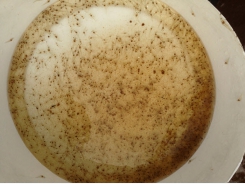Shrimp farming industry in Ecuador, part 2

Improvement plan, production technology improvements and perspectives
Ecuadorean shrimp farmers have incorporated several technological advances to improve shrimp growth and disease resistance, to optimize the use of water and aquafeeds, and to increase production levels and resource optimization. Photo by Dr. Xavier Romero Martínez @xrfotografia.
The shrimp production chain is one of high economic, social and environmental importance for Ecuador. The Ministry of Foreign Trade (MCE) and the Ministry of Agriculture, Livestock, Aquaculture and Fisheries (MAGAP) – and in coordination with the Ministry of the Environment (MAE) – drew up a competitive improvement plan (PMC) for the shrimp production chain, with the participation of the most relevant actors from the private and public sector.
The main opportunities identified and prioritized in the production shrimp chain address the low production of Asian competitors and the demand of China; the opening of new markets; the increase in the consumption of organic foods; and the demand for nauplii and broodstock.
An additional focus is the potential support of the state, given the interest of public entities in the chain, not only because of their current economic and social weight, but also because of the possibilities of greater contributions in terms of trade balance, contribution to the economically active population (PEA) and activation of local economic dynamics.
On the other hand, weaknesses were identified and corresponding corrective actions were proposed, namely: the vulnerability of markets; an inadequate legal framework, with excessive legal procedures for formal actors and deficient regulation for intermediaries; the lack of security against criminal events; poor access to financing for production and exports; low level of research and innovation, especially at the level of medium and small producers; and insufficient road and electrical infrastructure.
This information has served as the basis for the implementation of actions for the benefit of the industry. Currently, a plan is underway to bring power to about 100,000 hectares of shrimp farms, which will allow a change in the use of energy and the use of new technologies for the operation of the farms (surveillance systems, monitoring, feeding, aeration, etc.). The regulation that controls the activity was also reformed (Fishing Law Regulation), so that, among other changes, the term could be extended to shrimp concessions from 10 to 20 years, allowing investment in the sector.
In 2017, the Ministry of Aquaculture and Fisheries was created, an institution dedicated more specifically to aquaculture activities (previously regulated by the Ministry of Agriculture). Proposals are also being debated for a new Aquaculture and Fisheries Law that would better cover the current needs of the sector, as the current law is from 1974, when the shrimp industry still did not represent a main activity for the national economy.
Farming system technologies
The industry has incorporated technological advances to improve shrimp growth and resistance to pathogens, as well as to optimize the use of water and aquafeeds, increasing production levels per hectare and optimizing resources. There are some tools that Ecuador’s producers make use of, among which the most important are:
Raceways and nurseries
The use of raceways, concrete tanks or tanks covered with a geomembrane, as well as small, earthen nursery ponds has improved shrimp survival in farms and reduced the days of culture in the grow-out phase. Keeping animals in controlled systems – where better feeding is provided and physical-chemical parameters are controlled – has considerably improved final yields and has increased pond rotation, resulting in more annual yield per hectare without increasing stocking densities.

View of raceways used to grow larger animals before stocking in grow-out ponds. Photo by Darryl Jory.
Aeration
The use of mechanical aerators – to homogenize pond water and mostly to keep dissolved oxygen concentrations at optimal levels for crop support and development – has been one of the first changes the industry has adopted. At present, shrimp farms that have raceways and nursery systems use mechanical aeration as they maintain higher densities in these phases (mainly diffuser hoses, Venturi systems or paddlewheel aerators, depending on pond size).
In grow-out ponds where stocking densities have been increased, aerators – mainly paddlewheel types – are used to improve water circulation in the pond and maintain acceptable levels of dissolved oxygen. However, we cannot state that the use of mechanical aerators is widespread, because there is still a high percentage of farms that maintain the traditional farming systems with low densities and direct stocking.
Automatic feeding
The high cost manufactured aquafeeds, which represents more than 50 percent of direct production costs, has motivated the search for alternatives to optimize their management. Technological advances have made available several alternatives to automate feeding, some with sensors that allow the automatic adjustment of feed supply according to shrimp demand, and others that are manually adjusted based on feedback from survival sampling and from feed tables recommended by the manufacturers.
The automation of feeding has allowed a feed consumption reduction of up to 30 percent, and improved FCRs. In addition, shrimp farmers report less size variation at harvest, and lower disease incidence in ponds where feed distribution is automated. The increase in shrimp volumes exported by Ecuador in 2016 and 2017 is due, in part, to the implementation of automated feeding systems in many farms, which along with other strategies described here, resulted in improved weekly growth and shorter growing cycles or increased harvest weights.
Advances in nutrition and functional feeds
Advances in the field of nutrition have resulted in the discovery of the benefits of new products and improved feed formulations, adding products such as plant extracts (essential oils) and organic salts that are used to chelate certain minerals, to change the pH of the digestive tract, to activate enzymes, and reduce the incidence of pathogenic bacteria, among other benefits.
Amino acids, prebiotics, probiotics and other additives are also used to help improve the physiological response of animals to different stress conditions during culture. The leading companies in animal nutrition and feed production have investments or are represented in Ecuador, so that producers have access to high quality aquafeeds made with the best ingredients and processes available in the market.
Bioremediation
The use of bioremediating bacteria has become widespread in shrimp farms and in Ecuador’s seed production centers. A large number of brands containing inactivated strains of bacteria – especially of the genus Bacillus – are used to inoculate and colonize the culture systems, displacing other bacteria that may be pathogenic, and to improve the quality of pond water and bottoms. This has led to a reduction in water exchange rates and the related energy costs and has also reduced the entry of pathogenic vectors and the need to apply antimicrobials in crops.
Currently, symbiotic systems have also gained renewed interest; these systems use fermented rice bran with added minerals and probiotics and are used as a water treatment to control Vibrio levels, improve turbidity, balance phytoplankton, stabilize the pH and mineralize pond bottoms. Although these symbiotic systems are still used more in a rather experimental way and are copied from those systems used in Asia, they offer an alternative to reduce the use of manufactured aquafeeds and the rate of water exchange.
Water recirculation
The use of aerators, bio-remediators and other tools to improve water quality and enrich farming systems has led some farms to develop water recirculation in their pond systems to reduce the risk of bringing in new, outside water of poor quality as well as potential pathogens or disease vectors. Although there are still very few farms that have already implemented recirculation systems in their operations, this alternative is considered the best option for the development of shrimp farming.
Technology for crop monitoring and management
With the advancement of information and communication technologies (ICTs), various such tools have been implemented to support the industry. Currently, shrimp farms in Ecuador have implemented video surveillance systems of their facilities (sadly, the industry is strongly affected by crime); adjustment of aquafeed rations in automatic feeders according to demand; monitoring of various water parameters; establishment of early warning systems for disease prevention; assessment of project profitability according to crop sizes and market conditions, and others. Companies that manufacture and market aquafeeds, for example, have smartphone applications that allow access to important information in real time for making critical, timely crop-management decisions.

Ecuadorian shrimp has achieved a high-quality standard and access to global markets.
Industry perspectives
The growth of shrimp farming in Ecuador is limited by the scarcity of land available for the construction of new ponds. Given this, the industry is committed to improving the productivity levels of existing pond area as an alternative to increase production levels.
For this reason, many farms are redistributing their culture areas and building nursery raceways and ponds that allows shortening the grow-out time and achieve more production cycles per year. Faced with water quality problems and sources of pollution from anthropogenic activities due to the growth of nearby cities, there are farms that have implemented recirculation systems to minimize the dependence water use from the surrounding natural bodies, thus reducing risks from diseases and dangerous pollutants.
Increased technology usage has also arrived at many farms. The good results achieved through the use of automatic feeders have encouraged the increased use of these devices, resulting in a significant reduction in feed conversion rates and improving profitability. This has also improved the state of health of the cultured shrimp by providing food more efficiently and with less impact on pond bottoms. And it has also motivated some shrimp farmers to increase culture densities, helped by the use of mechanical aerators to support a higher biomass in the ponds and the also the use of bio-remediators.
To achieve its goals, the industry must work hard on sustainability issues. The elimination of antimicrobials in the production chain is something it has focused its efforts from different angles. However, the threat of emerging diseases or disease outbreaks of pathogens already present in the environment are an obstacle to achieving this in the short term, so shrimp companies are working in the search for viable alternatives for cleaner production, even though Ecuador’s industry has an excellent record regarding alerts or rejections for the use of veterinary medicines.
Regarding commercial issues and market access, the reopening of exports to Brazil earlier this year provides the opportunity to increase exports by more than 30,000 MT/year. Together with the foreign trade authorities, the industry works for the signing of favorable trade agreements and the elimination of barriers that allow its products to be more competitive and to increase exports to the same extent that production is promoted.

The Ecuadorean shrimp farming industry recently launched its Shrimp Sustainable Partnership, an initiative that promotes the production of antibiotics-free shrimp in an environment of, and under the strictest standards of environmental, social and business ethics sustainability.
Ecuadorian shrimp has achieved a high-quality standard, which allows it to access all markets without restrictions, since there are no detentions due to contamination or the use of controlled substances. However, Ecuador wants to go further in the quality of its shrimp and during the last Seafood Expo North America in Boston, Mass., it launched its Shrimp Sustainable Partnership (SSP), an initiative that promotes the production of antibiotics-free shrimp in an environment of, and under the strictest standards of environmental, social and business ethics sustainability.
This program, which in principle has already been accepted by the largest producers and exporters in the country, will further raise the quality standard of shrimp offered by Ecuador and will provide the market with what we believe is the best shrimp in the world, following the slogan adopted by the industry since 2014.
Related news
Tools

Phối trộn thức ăn chăn nuôi

Pha dung dịch thủy canh

Định mức cho tôm ăn

Phối trộn phân bón NPK

Xác định tỷ lệ tôm sống

Chuyển đổi đơn vị phân bón

Xác định công suất sục khí

Chuyển đổi đơn vị tôm

Tính diện tích nhà kính

Tính thể tích ao




 App aims to bring clarity to seafood traceability,…
App aims to bring clarity to seafood traceability,…  Carbon-nitrogen ratios in pond fertilization and biofloc systems
Carbon-nitrogen ratios in pond fertilization and biofloc systems